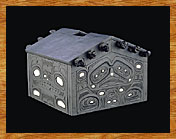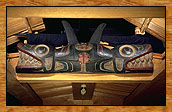 Housefront Housefront
 Paintings Paintings
 Carved Interior Carved Interior
 Poles and Posts Poles and Posts
 Interior Screens, Interior Screens,
 Housepits, and Housepits, and
 Smokeholes Smokeholes
 |
Interior Screens, Housepits and Smokeholes
Few examples survive of the Haida decorated screen that stood between the rear house posts, comparable to the spectacular interior screens of their Tsimshian and Tlingit neighbours. These wall partitions could be assembled in front of the chief's compartment to conceal dancers as they put on their costumes and prepared to perform. Access to the public area was through a round or oval doorway that formed part of an ancestral or crest figure painted on the screen.
One model of a house from Kiusta village, made by Charles Edenshaw for John R. Swanton, has a doorway in the mouth of a froglike design (said to represent Konankada) on the screen. The most spectacular surviving Haida screen is from Howkan village in Alaska. George T. Emmons, who collected this piece, identifies its images in his unpublished notes (no date) but does not identify the house from which it came.

 |
An argillite model of a house in which the figures at the ends of the rafters portray singers who perform when anyone approaches. The housefront is decorated with the image of a Grizzly Bear.
Acquired on Haida Gwaii (probably Skidegate) circa 1892 by James Deans for the Aaronson collection.
CMC VII-B-816 (S92-4274) |

Other features of the Haida house that were sometimes elaborated with carving or painting were the rafters, the retaining planks that framed the house pit surrounding the central fireplace, and the timbers around the smokehole above the fireplace. No carved housepit planks survive for the Haida (though there are Tlingit and Tsimshian examples), but the most elaborate of all known examples from anywhere on the coast belonged to Charles Edenshaw's son Henry in the village of Klinkwan, Alaska. The design is composed of elaborately carved and painted chests (with opercula shell inlay) that alternate with engraved coppers. Although Henry Edenshaw inherited this house, it was probably built by Albert Edward Edenshaw, who may have commissioned his nephew Charles Edenshaw to create this design.
The smokehole had mythical significance among the Haida, as it was the opening through which souls entered and left the house at birth and death, following the pathway of smoke uniting this world to the upper world and the Milky Way, which was the pathway of souls in the sky. It was also the opening through which the trickster-hero Raven escaped to carry his gifts of the sun, the moon and the stars to humans. It was while flying through this opening that the White Raven, the primal form, turned black in the smoke.
One notable smokehole carving depicts a double-headed Killer Whale with prominent dorsal fins. In form, it resembles the double-headed soul catchers traditionally used by Tsimshian shaman but on occasion by Haida shaman as well. The placement of a soul catcher as a device to protect souls in the smokehole of a house presents some intriguing equations in the cycles of birth and death.

 |
A small human figure crouches between two Killer Whales on this protective device made in the form of a shaman's soul catcher. It may have been placed in the smokehole of a house to prevent the souls of its inhabitants from wandering away during illness. The painted details are Tsimshian in style, but the piece is recorded as Haida in the catalogue of the Lord Bossom collection.
Acquired by George T. Emmons before 1900 for the Lord Bossom collection.
CMC VII-B-1821 (S92-4385) |

|